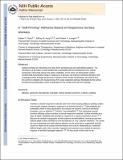| dc.contributor.author | Chan, Edwin P. | |
| dc.contributor.author | Karp, Jeffrey Michael | |
| dc.contributor.author | Langer, Robert | |
| dc.date.accessioned | 2013-08-08T20:32:41Z | |
| dc.date.available | 2013-08-08T20:32:41Z | |
| dc.date.issued | 2011-01 | |
| dc.identifier.issn | 08876266 | |
| dc.identifier.issn | 1099-0488 | |
| dc.identifier.uri | http://hdl.handle.net/1721.1/79820 | |
| dc.description | available in PMC 2012 January 1. | en_US |
| dc.description.abstract | Surface wrinkles are interesting since they form spontaneously into well-defined patterns. The mechanism of formation is well-studied and is associated with the development of a critical compressive stress that induces the elastic instability. In this work, we demonstrate surface wrinkles that dynamically change in response to a stimulus can improve interfacial adhesion with a hydrogel surface through the dynamic evolution of the wrinkle morphology. We observe that this control is related to the local pinning of the crack separation pathway facilitated by the surface wrinkles during debonding, which is dependent on the contact time with the hydrogel. | en_US |
| dc.description.sponsorship | National Science Foundation (U.S.) (NIRT grant 0609182) | en_US |
| dc.description.sponsorship | National Science Foundation (U.S.) (NIH grant DE013023) | en_US |
| dc.description.sponsorship | Center for Integration of Medicine and Innovative Technology (U.S. Army grant W81XWH-07-2-0011) | en_US |
| dc.description.sponsorship | Center for Integration of Medicine and Innovative Technology (NIH GM086433) | en_US |
| dc.description.sponsorship | University of Massachusetts (System) | en_US |
| dc.description.sponsorship | Massachusetts Technology Transfer Center | en_US |
| dc.description.sponsorship | American Heart Association (Grant 0835601D) | en_US |
| dc.language.iso | en_US | |
| dc.publisher | Wiley-Blackwell Publishers | en_US |
| dc.relation.isversionof | http://dx.doi.org/10.1002/polb.22165 | en_US |
| dc.rights | Creative Commons Attribution-Noncommercial-Share Alike 3.0 | en_US |
| dc.rights.uri | http://creativecommons.org/licenses/by-nc-sa/3.0/ | en_US |
| dc.source | PMC | en_US |
| dc.title | A “self-pinning” adhesive based on responsive surface wrinkles | en_US |
| dc.type | Article | en_US |
| dc.identifier.citation | Chan, Edwin P., Jeffrey M. Karp, and Robert S. Langer. A self-pinning” Adhesive Based on Responsive Surface Wrinkles. Journal of Polymer Science Part B: Polymer Physics 49, no. 1 (January 1, 2011): 40-44. | en_US |
| dc.contributor.department | delete | en_US |
| dc.contributor.department | Harvard University--MIT Division of Health Sciences and Technology | en_US |
| dc.contributor.department | Massachusetts Institute of Technology. Department of Chemical Engineering | en_US |
| dc.contributor.mitauthor | Chan, Edwin P. | en_US |
| dc.contributor.mitauthor | Karp, Jeffrey Michael | en_US |
| dc.contributor.mitauthor | Langer, Robert | en_US |
| dc.relation.journal | Journal of Polymer Science Part B: Polymer Physics | en_US |
| dc.eprint.version | Author's final manuscript | en_US |
| dc.type.uri | http://purl.org/eprint/type/JournalArticle | en_US |
| eprint.status | http://purl.org/eprint/status/PeerReviewed | en_US |
| dspace.orderedauthors | Chan, Edwin P.; Karp, Jeffrey M.; Langer, Robert S. | en_US |
| dc.identifier.orcid | https://orcid.org/0000-0003-4255-0492 | |
| mit.license | OPEN_ACCESS_POLICY | en_US |
| mit.metadata.status | Complete | |
